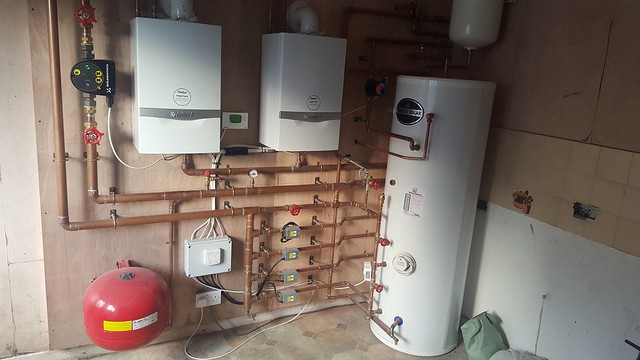Soldato
I'm currently redoing a town house, as part of this we're turning the main bathroom into a wet room with thermostatic shower (high pressure would be nice).
Currently, we have a Valiant ecoTEC Plus 418, with an indirect 117 litre cylinder. Both of these are located on the ground floor, part of a conventional system so header tank/expansion in the loft.
Our wet room will be on the 2nd floor, kind of straight line from the cylinder with slight offset. The total distance from cylinder to bathroom floor straight up is around 4.8M, adding another 2m if you consider the spout height in bathroom would be from ceiling or top of wall dependant on shower choice.
Now, with 117 litre cylinder we're expecting a short shower... and are worried about it providing 2 showers every morning lasting say 20 minutes a piece. Not only that, if we have guests it would be nice to have 4-5 showers in succession.
The only testing we've done thus far is flow, and we're achieving at the moment 10 litre/minute on hot and cold feeds independently. I thought that was fairly good, as it's pushing up 2 floors and from what I can tell no hot water/shower pump fitted. Is this likely however to deliver a nice powerful shower?
What options are open to us? All of the pipe work is currently exposed... but can the existing hot water cylinder be swapped out for something like a megaflow?
Any help would be much appreciated! Boiler systems still miff me, despite learning a ton by doing the house. Would be great to get the options on the table, as well as any concerns I have confirmed.
Currently, we have a Valiant ecoTEC Plus 418, with an indirect 117 litre cylinder. Both of these are located on the ground floor, part of a conventional system so header tank/expansion in the loft.
Our wet room will be on the 2nd floor, kind of straight line from the cylinder with slight offset. The total distance from cylinder to bathroom floor straight up is around 4.8M, adding another 2m if you consider the spout height in bathroom would be from ceiling or top of wall dependant on shower choice.
Now, with 117 litre cylinder we're expecting a short shower... and are worried about it providing 2 showers every morning lasting say 20 minutes a piece. Not only that, if we have guests it would be nice to have 4-5 showers in succession.
The only testing we've done thus far is flow, and we're achieving at the moment 10 litre/minute on hot and cold feeds independently. I thought that was fairly good, as it's pushing up 2 floors and from what I can tell no hot water/shower pump fitted. Is this likely however to deliver a nice powerful shower?
What options are open to us? All of the pipe work is currently exposed... but can the existing hot water cylinder be swapped out for something like a megaflow?
Any help would be much appreciated! Boiler systems still miff me, despite learning a ton by doing the house. Would be great to get the options on the table, as well as any concerns I have confirmed.



 . Does it!?
. Does it!? 
 Boiler room
Boiler room